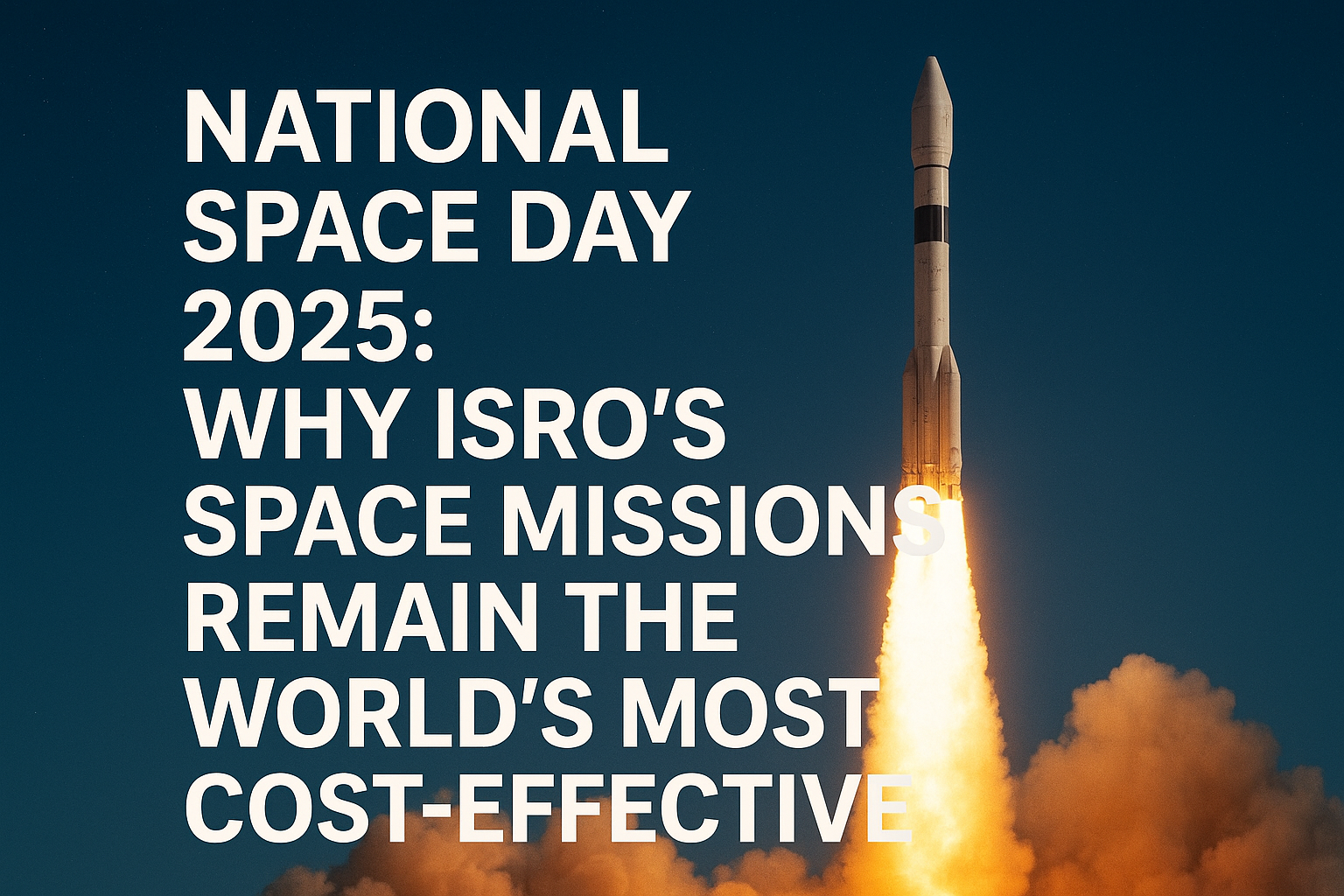
National Space Day 2025: Why ISRO’s Space Missions Remain the World’s Most Cost-Effective
Introduction
As India celebrates National Space Day 2025 on August 23, the spotlight once again turns to the Indian Space Research Organisation (ISRO) — an institution that has redefined space exploration by achieving remarkable missions on surprisingly modest budgets. From the Mars Orbiter Mission (Mangalyaan) to Chandrayaan-3’s south pole landing, ISRO has earned global admiration not just for its technological achievements but for its unique culture of frugality and innovation.
Smart, Not Expensive
The idea of cost-efficiency at ISRO is not accidental. It is deeply rooted in its history. In the 1970s, following India’s nuclear tests, international sanctions barred the country from accessing advanced foreign technologies. Instead of slowing down, this adversity pushed ISRO to develop indigenous solutions. Former ISRO Budget Director P. Sudarshan once remarked that sanctions became “a blessing in disguise,” forcing Indian scientists to innovate and build everything in-house.
This philosophy of “doing more with less” remains a defining feature. Whether it’s transporting rocket parts on bullock carts in the early years or using simulations instead of costly prototypes, ISRO has always prioritized ingenuity over extravagance.
Landmark Missions on a Shoestring Budget
ISRO’s reputation for low-cost yet highly reliable missions is best reflected in some of its milestone projects:
- Mars Orbiter Mission (MOM): Launched in 2013 at a cost of just $74 million, Mangalyaan placed a spacecraft in Mars’ orbit on the very first attempt—something no other space agency achieved. The mission cost less than the Hollywood film The Martian.
- Chandrayaan-1 (2008): At $82 million, this mission discovered water molecules on the Moon—a breakthrough in lunar science achieved for a fraction of global costs.
- Chandrayaan-3 (2023): With a budget in the hundreds of crores, this mission successfully landed near the Moon’s south pole, a feat witnessed by the entire world.
- Launch Vehicles: ISRO’s Polar Satellite Launch Vehicle (PSLV) costs just around $20 million per launch, while the GSLV operates at about $30 million. In comparison, Europe’s Ariane 5 costs about $165 million per launch.
Other achievements include Astrosat ($100 million), IRNSS/NavIC ($200 million), and RISAT-2 ($100 million), all executed at costs that astonished the global space community.
The Strategy Behind the Savings
Experts emphasize that ISRO’s frugality goes beyond engineering. It is also about policy choices and ecosystem building. Initiatives like IN-SPACe have opened the door for private sector collaboration, enabling efficiency while boosting competitiveness.
Dr. Suresh Naik, ISRO’s Ex-Group Director, highlights that one key to cost savings lies in choosing the right rocket for the right mission. By avoiding oversized vehicles and carefully planning trajectories, ISRO saves fuel and manpower costs. He explains, “We work with tight time schedules, so manpower cost comes down. The reliability of our rockets is high at a low cost.”
Self-Reliance at the Core
India’s drive for self-reliance (Atmanirbharta) is another pillar of ISRO’s cost-effectiveness. Almost all components are manufactured domestically, reducing dependence on imports. The relatively lower cost of skilled labour also makes Indian missions cheaper than those of Western counterparts. Yet, this affordability does not come at the cost of quality. ISRO rockets are regarded as among the most reliable in the world.
Inspiring the Next Generation
Recent missions have inspired not just scientists but also young students across the country. Group Captain Shubhanshu Shukla, who became the first Indian astronaut to travel to the International Space Station in collaboration with Axiom Space, NASA, SpaceX, and ISRO, has become a role model for aspiring space scientists. Students like Avani Advani express their desire to follow ISRO’s path, learning to design cost-effective space technologies.
The Global Contrast
While agencies like NASA or ESA operate with significantly higher budgets, ISRO’s necessity-driven innovation ensures that India achieves comparable results at a fraction of the cost. Other agencies often spend more on redundancy, insurance, and outsourcing, while ISRO thrives on lean design and indigenous development.
This efficiency has made ISRO’s launch services attractive globally. Countries now prefer to launch satellites via Indian rockets, which are faster, cheaper, and highly reliable.
Conclusion
On National Space Day 2025, ISRO’s story stands as proof that space exploration doesn’t need to be extravagant. India’s journey from carrying rocket parts on bicycles to landing near the Moon’s south pole shows the power of innovation born from constraints. By focusing on self-reliance, indigenous innovation, and smart decision-making, ISRO has made space not just the final frontier, but also an affordable frontier.
As the world looks for sustainable models of space exploration, ISRO’s cost-effective approach is likely to serve as a blueprint for the future.



